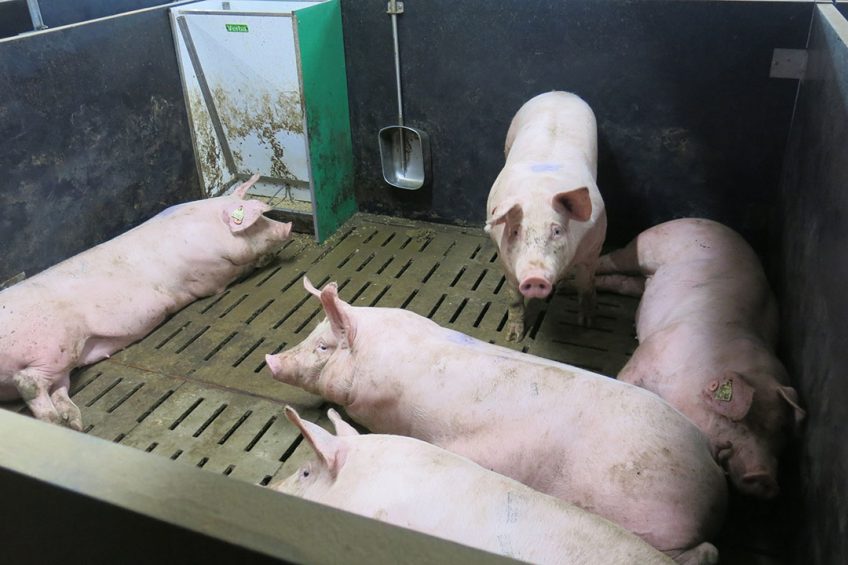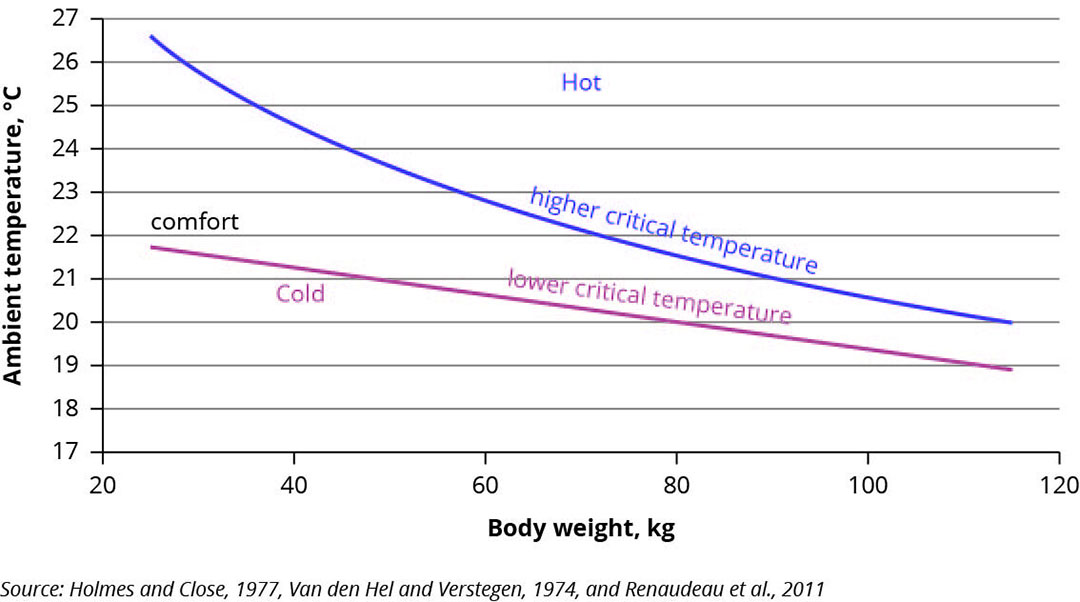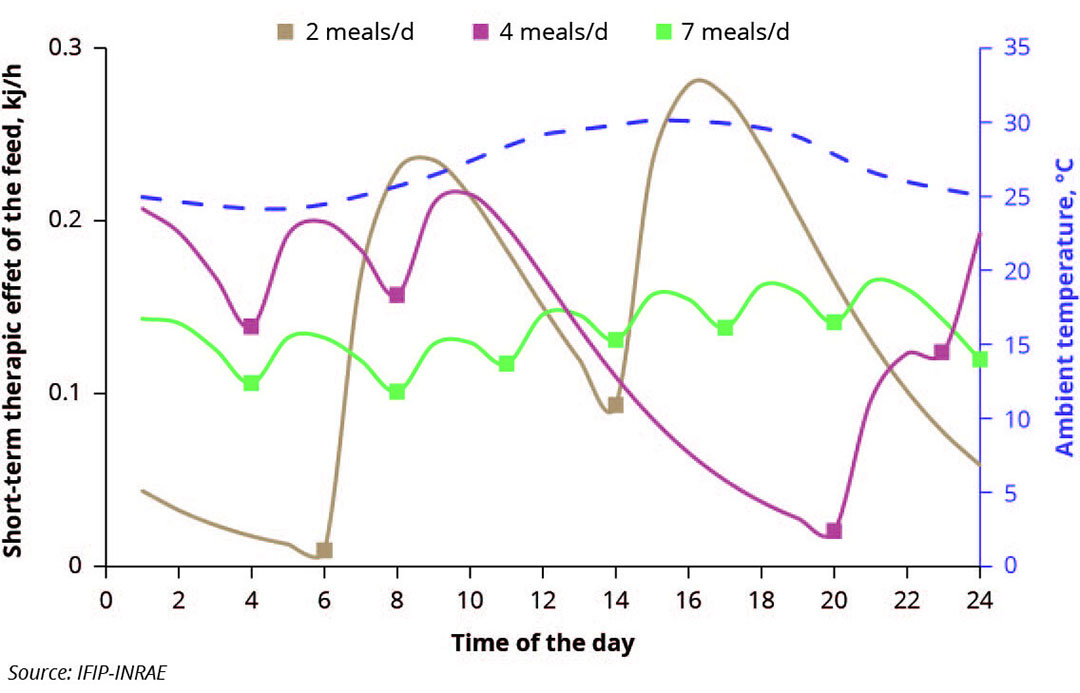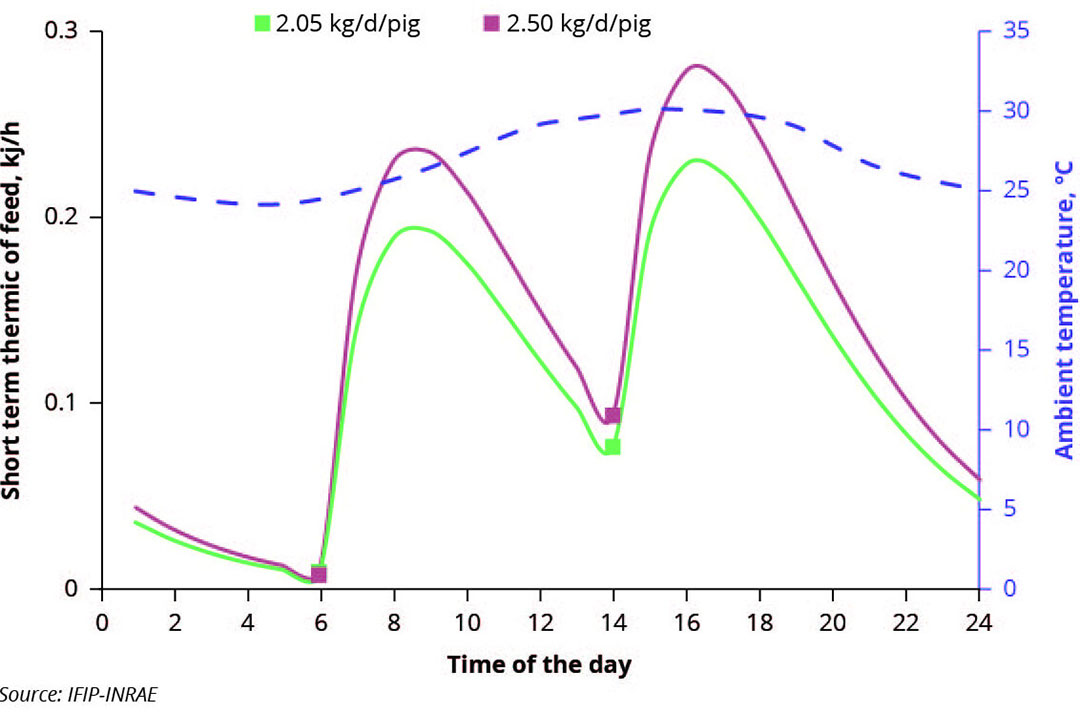Can we face heat waves with adapted feeding strategies?

In the context of global warming, heat waves have been observed repeatedly. Adaptations of the feeding strategy have been investigated to mitigate the impact of acute heat stress events on the short and long-term performance of lactating sows and finishing pigs.
Heat waves have been observed each year with an increased frequency and severity over the last decade. Under the extremely hot events observed in late spring and summer, called heat waves, most European pig farms are not equipped with systems that could efficiently prevent the indoor temperature from increasing above the thermoneutral zone (Figure 1).
Figure 1 – Thermoneutral zone of growing pigs on fully slatted floor.

With a rapid increase in temperature the consequences on the animal physiology are not well described, compared to the impact of a progressive increase in the intensity of chronic heat stress. When the temperature increases above the upper critical temperature, different adaptations are progressively observed, including those that contribute to higher heat losses (panting, posture, peripheral blood circulation…) or lower heat production (reduced physical activity, feed intake, growth and milk production). At a given temperature, the risk to being exposed to hot conditions is higher for lactating sows, due to their high level of feed intake and milk production, and finishing pigs, due to their elevated feeding level and body fatness.
Long-term effects on animal performance
Recently, it has been shown that summer heat waves have short and long-term effects on animal performance. That includes a strong reduction in voluntary feed intake during the acute heat stress event (with subsequent effects on digestive physiology and growth) and thereafter a lack of compensatory responses to heat stress induced feeding restriction.
In addition, both the dynamic of the physiological response and the sensitivity to temperature differ among individuals. An inter-individual variability has been observed for example in primiparous sows.
Under high ambient temperature, daily feed intake and milk production remain very high for some of them whereas they decrease for others. Subsequently the risk of being culled is higher after weaning for these animals, while less sensitive sows are more likely to be kept longer in the herd. In growing pigs, similar inter-individual variability was also established.
With specific feeds
In homeothermic animals, reduced metabolic heat production under heat stress conditions is an adaptation that helps to regulate the internal body temperature regardless of external influence. One third of the heat produced by the pig is due to the digestive and metabolic use of nutrients, so called the thermic effect of feed (TEF). This dietary characteristic can be assessed through the ratio between the net energy and metabolisable energy concentrations (NE/ME ratio). With regard to production of metabolic heat, a decrease in daily feed intake from 2.50 to 2.23 kg can be theoretically compensated through the increase in dietary NE content from 9.7 to 10.9 MJ/kg. Formulation of low TEF diets is usually achieved with a decreased value of the constraint applied to the maximum crude protein concentration (but for similar constraints in minimum concentration in essential amino acids), fat and fibres.
Many research teams focus their investigations on the incorporation of specific additives (antioxidant molecules, functional amino acids/peptides, live yeasts, sodium bicarbonate…) in order to cover the specific need due to the thermoregulation efforts.
However, up until recently these kinds of formulation have been mainly used in warm climates such as Asia and Australia. In Europe, they are used sometimes at the beginning of the warm season, to reduce the impact of a chronic heat stress on performance, mainly in lactating sows.
In practice, it is difficult to switch from one diet to another in a reactive way based on feed delivery systems currently installed in commercial pig farms. But new equipment, such as electronic feed dispensers developed with 2 or 3 hoppers could help to modulate the quality of the diet delivered in a very reactive way.
Figure 2 – Post-prandial heat production depends on meal size (then on the number of meals for a given feed allowance).

Adjusted feed delivery
A different partition of feed intake is expected to attenuate the impact of high ambient temperature. Trials performed in respiratory chambers at the experimental station INRAE (Saint-Gilles, Brittany, France) provided some information about the dynamics of heat production, especially heat released after a feed. The bigger the meal is, the more important the heat to be released is. However, the heat is not immediately released after the feed. Due to the metabolic process involved in the digestion and the physiological use of the energy intake, the short-term thermic effect of the diet is observed over the few hours following a feed (Figure 2). Then again after a feed, taken 1 hour before the time when the ambient temperature peaks above thermoneutral conditions, the amount of heat to be released is still important. The situation the animal faced was all the more difficult as the feed was spontaneously large.
Numerous small meals
Difficulty losing heat under such conditions may have long term effects, with impaired performance even when the heat waves are over. In contrast, dividing feed intake into numerous small meals before the arrival of the heat wave can prevent rocketing post-prandial heat production with a potentially reduced intensity of heat stress and long-term consequences (Figure 2).
Feeding at cooler times of the day
Dividing feed intake over the day should be associated with changes in the time of feed delivery, mainly towards the “less warm” periods of the day (Figure 2). Under a heat wave, it is not always possible to refer to the coldest period of the day as the decrease in ambient temperature that may occur during the night is rather limited, in contrast to what is observed under milder summer days. Under mild hot conditions, for example when temperature rises up to 29°C during the afternoon and decreases to around 20°C during the night, it is possible for the sow to consume the same amount of feed under a constant temperature of 25°C.
Reducing feed intake
But when temperature remains above 25°C, it is no longer the case and the higher it is, the more important it is to decrease the feed intake. Therefore, changing the delivery time of the feed is an option to decrease the intensity of heat stress during the warmest periods of the day.
Fluid intake should be the priority
Even though this article focuses mainly on nutritional strategies for coping with acute heat stress, the first attention has to be paid on water supply. Providing clean and cool drinking water at all times can really helps animals that are kept under hot conditions. The animals have access to water ad libitum, all day long even when no feed is delivered. As pigs can stop eating in hot conditions, the administration of functional additives via the drinking water supply would have benefits to help the animal cope with heat stress. In the past, in farms equipped with liquid feeding system but without a drinking bowl in the farrowing pens, farmers were advised to deliver water separately from the feed instead of diluting the liquid feed. Nowadays, if drinking bowls or nipples are installed to fit in with legislation, that solves the problem.
Figure 3 – Heat production is reduced with smaller meals.

Weather warning
Finally, based on weather forecasts, it is possible to anticipate and mitigate extremely hot periods. When a heat wave is forecast, this gives ample time to modify the parameters of the feed delivery; reducing the amount of feed delivered per animal and at modified times (Figure 3). The aim is to reduce the thermoregulatory effort for pigs, so that they can recover rapidly after acute heat stress. Such a strategy could also help prevent mortality rates, which increases with heat waves.







